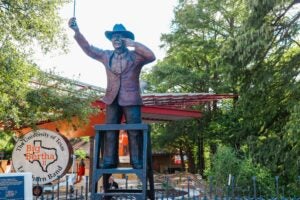AUSTIN, Texas — More than 2,000 University of Texas students, faculty, staff, and administrators and members of the general public have expressed an opinion on what sculpture of Martin Luther King Jr. they would like to see erected on the East Mall of the UT campus. Their comments followed the public unveiling of the MLK maquettes, or models, at UT last month.
The Chicago-based husband and wife team, Jeffrey Hanson Varilla and Anna Koh-Varilla received the most endorsements, a total of 896, equaling 48 percent of responses, followed by Ed Dwight of Denver, Colo. with 702 (37 percent) expressions of approval. Ralph Helmick, the Newton, Mass.-based artist was third with 163 endorsements (8 percent) followed by Wendy Ross of Bethesda, Md. with 94 endorsements (5 percent). Tina Allen of Beverly Hills received a total of 36 expressions of approval representing 2 percent of the total.
The Varillas chose to portray King dressed in his doctoral robes which they believe shows a man of philosophy and intellect appropriate for a university setting. “Through our sculpture, Dr. King is depicted as a man of leadership, as a man of scholarship and as a man of fellowship,” stated the Varillas. The sculpture is placed on a bronze pedestal based on the design of the pulpit King used at the Ebenezer Baptist Church. The pedestal contains four bas relief panels, one depicting the Lincoln Memorial where King gave his famous “I Have a Dream” speech, another showing peaceful demonstrators and marchers enduring the slings and arrows of racism and abuse, and one illustrating King in the infamous Birmingham jail. The back panel, according to the Varillas, is not only a sculpture but a requiem portraying Coretta King and one of her children grieving and enduring the loss of King. Each panel is accompanied by quotations from King’s own speeches and writings which they feel were perfect choices to intensify the drama of the relief sculptures.
Dwight’s maquette depicts a sculptural group, the core of which is the King Memorial where, according to Dwight, King is represented as the “teacher” that he was. “Using a calming gesture with his left hand, his other hand rests on a bible that sits atop his preaching robe folded over a pedestal,” said Dwight in his design proposal. Dwight’s model is based on his belief that King did not rise to his prominence in a vacuum, which is why he has portrayed him standing metaphorically on the shoulders of four historically important personalities: Frederick Douglas, Sojourner Truth, Rosa Parks and Mahatma Ghandi. This sculptural group sits atop a classic granite monolith that contains a summary of King’s accomplishments in bas relief and is accompanied by an elaborate site plan that provides a history of what King’s “struggle” was about.
The sculptural maquette created by Helmick depicts a large bronze portrait head of King whose hair texture provides the viewer with text drawn from his oratory and writings. “These quotations,” as Helmick states in a description of his project, “evoke the history and accomplishments of the man, his community and the entire civil rights movement.” The sculpture rests directly on the ground plane which Helmick believes puts King on equal footing with the viewer and promotes a feeling of radical empathy and sense of being with – not just looking at – the art work.
Ross’ site plan places King, with arm stretched outward, before a granite boulder which according to Ross, “conveys solidity, the Rock of Ages, the biblical mountain top from which Dr. King, like Moses, was permitted to see the Promised Land.” Ross believes her likeness of King is dynamic and engaging with an animated expression and mouth open as if he were speaking. In his left hand, he is carrying a book by Ghandi who served as a focal point for King’s teachings. The sculpture and boulder sits atop of a circular granite base that contains four large bronze plaques carrying significant quotes made by King.
Allen chose to depict King in his doctoral robes holding a globe of the world. According to Allen, one of King’s hands shields the globe, while the other beckons the viewer to consider the universal and global impact of thought. “The globe is meant to remind the viewer of the great unifying reality of life on this planet. It is meant to remind us of our responsibility to each other and future generations, as we are all part of the human family,” wrote Allen in her design proposal. King’s head is lifted slightly upward and, as Allen suggests, makes reference to his inspirational thinking offering the viewer a chance to see faith as an important component in developing greatness.
Comments on these sculptures from both the UT Austin community and the general public streamed in over a four week period from Sept. 23rd through Oct. 21st.
“While this was in no way a scientific polling of the campus community, we are extremely pleased that so many students, faculty, staff, administrators and Austin area residents commented on the sculptures and offered some very insightful observations about each artist’s version of how they would portray Dr. King,” said Terry A. Wilson, chairman of the MLK Sculpture Project and associate director of the Office of Public Affairs.
“The comments and suggestions will be made available to each MLK Sculpture Committee member at an October 28th meeting. At that time, all of the artists, the committee, the expert panel of jurors and the facilitators from the Texas Commission on the Arts will convene to interview each finalist to decide which artist will be awarded the commission for the project,” said Wilson.
After committee members have decided which artist should receive the commission to construct the sculpture of MLK, they will make a recommendation to Dr. Peter T. Flawn, UT Austin president ad interim, who will in turn request final approval at the University of Texas System Board of Regents meeting in November.
Each artist’s vision of the sculpture elicited different responses from among the 1,896 individuals who commented on the sculptures, as well as the site plans offered by Dwight, Ross and Helmick. The following is a short, but representative sample of comments offered about each maquette:
- Anna Koh and Jeffrey Varilla:
- “This statue has the most commanding presence. His right hand beckons you to approach. His face is dignified and most importantly, his eyes really engage yours.”
- “Very appropriate for a university environment, the most in synch with the UT Master Plan. Shows a spirit of compassion, the emphasis on unity and brotherhood in his outstretched hand. The message is forgiving, uncomplicated and simple, as was MLK’s message.”
- “I actually lost my breath when I saw this statue.”
- “This sculpture moves me, I can see the soul of the Dr. (Dr. King) in those eyes.”
- Ed Dwight:
- “Mr. Dwight’s proposal is a great monument not only to Martin Luther King, but also to other great people who fought for freedom.”
- “This is a wonderful representation of diversity and equality.”
- “Ed Dwight’s sculpture and plan is so grand and comprehensive. Its forms and words would be powerful.”
- “I really like how it includes other historical figures as well. It shows the collaboration over the years of civil rights. Wall of quotations is brilliant!”
- “I felt that Mr. Dwight’s piece was most successful in being an all-encompassing view of King’s life and I also value its recognition that King did not work alone. I feel that his inclusion of the four other persons in this piece is very meaningful and effective.”
- Ralph Helmick:
- “I love the speech in his hair — it is a very original idea and in future years, as the memory of man fades and parents are asked by wondering children, “Who is that?” They can share the dream.”
- “The simplicity of this sculpture makes it very powerful. It conveys a sense of inner presence and spirituality.”
- “As an image (in and of itself) it is the most striking of the entries and would be most memorable. Also, the most approachable, accessible, the most innovative and unusual.”
- “A stunning model that changes a viewer’s perception of the world.”
- “Clean and unpretentious, simple and instrumental.”
- Wendy Ross:
- “Her work captures the entire King, not just the head but the body as well with no necessary ornamentation.”
- “… MLK looks like the gentle and peaceful man he must have been in the sculptures. I think W. Ross is the only one that captures MLK’s passion, life and aliveness.”
- “Represents MLK as a friend to all and reaching out to our maker.”
- “Strong, powerful, colloquial in the best sense.”
- “Eloquently speaks to reality and this will be ever-inspiring.”
- Tina Allen:
- “Dr. King preaching on the world has a more universal appeal than preaching from a scripture. Also, I don’t think he was about being put on a pedestal.”
- “I particularly like the globe in hands metaphor…”
- “Great, he comes across as a scholar and leader.”
- “Far and away the most peaceful, impressive statue.”
- “Demonstrates King’s global thinking — Man in motion. Member of the community.”
In addition to the sample of representative positive comments about each artist’s version, respondents also provided some constructively critical comments. The following are representative samples of such comments:
- “Dwight’s is way too much. His sculpture is inappropriate for our campus setting — no other historical figure displayed on our campus with such extravagance and this sculpture is asking for a new controversy. Helmick’s is shocking. We have recently studied in a course at UT how African Americans have been depicted in advertising and other visual symbols. One way as the people being depicted with no limbs — why would we put a sculpture on our grounds that merely was a HEAD? This is demeaning.”
- “I think that in order to honor MLK, a modern political figure, we should set him apart from George Washington, Thomas Jefferson and the likes by depicting him in a way other than with Jeffrey Hanson Varilla and Anna Koh Varilla’s design.”
- “The Wendy Ross one looks like a cartoon — not like MLK.”…”The Ross is disproportionate.”
- “…The Allen sculpture is too crude… “Tina Allen’s sculpture looks lie an ancient monk and the figure resembles Nelson Mandela rather than MLK.””Each artist in his or her own way captured the essence of Dr. King and now the committee will have the difficult task of selecting the artist that best represents Dr. King and best expresses the vision of Dr. King as expressed by the entire university community,” said Marlen Whitly, UT Austin Student Government president and MLK Sculpture committee member.The maquettes will remain on display in the atrium of the new Student Services Building until Nov. 14th, and will then be moved a short distance and displayed in the Minority Information Center, just off the atrium area in the Student Services Building. The maquettes can also be viewed via our website at http://www.utexas.edu/general/mlksculpture.



